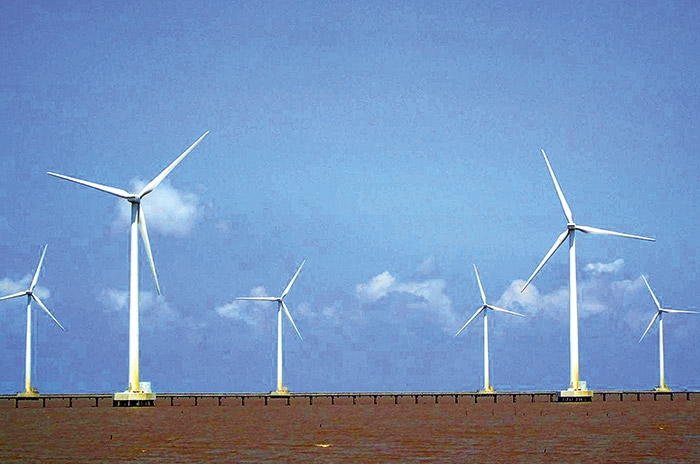More promising offshore energy
 |
| Vietnam boasts a solid energy policy, but there are calls to improve effectiveness, Photo: Le Toan |
Edgare Kerkwijk, board member of the Asia Wind Energy Association, told VIR last week at the Vietnam Offshore Wind Roundtable in Ho Chi Minh City that more offshore wind developers will come to the country as the government begins to map out offshore wind policies for the future.
“No government guarantee is needed as the current power price is sufficient enough to make offshore wind projects viable. However, one key issue is the bankability of power purchase agreements (PPAs) for onshore wind. It is important to have a new offshore wind PPA to drive the development of the sector,” he said.
In addition to support policies, the government should develop a co-ordinated approach with the involvement of different ministries. Kerkwijk said they need to come together to set out the roadmap for offshore wind development and should study which coastlines could be viable for projects and perhaps begin the measurements themselves.
Kerkwijk further noted some advantages of offshore wind in comparison with onshore. If Vietnam wants to have 10 gigawatts (GW) of renewable energy, offshore wind is a better way to achieve the target with around just 10 projects. Meanwhile, it needs a hundred onshore wind projects to generate the same amount of energy. Thus, it will achieve better business synergy and economy of scale when offshore wind farms combine in one area.
The port and grid can be upgraded to facilitate development and there are also no issues with land acquisition and densely populated areas, while the government is more controllable as ministries are involved, Kerkwijk concluded.
Eric Arends, director of Pondera Consult, said that European and eastern investors from South Korea and China are looking at Vietnam given that wind conditions seem favourable in some regions, especially the south-east. However, there needs to be more research to learn about wind resources and seabed conditions to set up the foundation for offshore wind farm projects.
“It is good for investors to look at Vietnam right now because they can get a picture of the entire situation in the country. Offshore wind development starts with all kinds of investigations of seabeds, fisheries, shipping, and military interests as well. As a result, investors can take a look at the market and build up experience and insight over time,” he said.
To promote offshore wind development in Vietnam, Arends recommended that the government should set up a system of issuing and granting offshore projects to developers as well as think about where to relocate offshore wind farms.
Vietnam has exceptional offshore and near-coast wind opportunities. Offshore wind conditions not far from large load centres such as Ho Chi Minh City have great potential according to the World Bank’s Energy Sector Management Assistance Programme, and with reasonable water depths between 20 and 50 metres, this could easily be a wonderful opportunity for Vietnam to add more global suppliers to its fledgling wind industry.
In June, the Global Wind Energy Council (GWEC) issued recommendations to help Vietnam increase its wind power capacity, in a document that was also signed by Siemens Gamesa, Vestas, Mainstream Renewable Power, and DNV GL.
“While Vietnam has a solid national energy policy and realistic targets, work still needs to be done to improve the effectiveness and transparency of the market rules as well as the procurement process,” said the GWEC.
The council noted with confidence that in working with the government on regulatory issues, the wind power sector in Vietnam can take off, “providing major economic and environmental benefits, as well as making Vietnam an attractive investment destination for international institutions and investors.”
Positively, the Vietnamese government approved the amendment of the feed-in tariff (FiT) for wind power defined by Decision No.37/2011/QD-TTg on the support mechanism for the development of wind power projects in Vietnam.
Under the new scheme, as from November 1, 2018, the FiT for wind power projects moves from 7.8 US cents per kilowatt-hour to 8.5 US cents for onshore wind power projects, and 9.8 cents for offshore projects.
What the stars mean:
★ Poor ★ ★ Promising ★★★ Good ★★★★ Very good ★★★★★ Exceptional
 Tag:
Tag:
Related Contents
Latest News
More News
- CSI 2025 highlights rise of Vietnam’s green champions (December 06, 2025 | 09:00)
- Vietnam’s forest carbon credits draw global interest (December 05, 2025 | 17:41)
- Coro Energy to launch BESS Pilot in Vietnam (December 04, 2025 | 15:12)
- Vietnam strengthens energy storage pathway (December 04, 2025 | 15:05)
- Women take leading role in agriculture and food systems (December 03, 2025 | 19:04)
- Experts highlight unpaid care work as key barrier to gender equality (December 03, 2025 | 15:15)
- Vietnam sets pace for dual transition in industry and trade (December 03, 2025 | 14:12)
- Harnessing technology for a sustainable future in Vietnam (December 03, 2025 | 12:17)
- Sustainability efforts on right track through policy and tech (December 03, 2025 | 12:05)
- Hanoi symposium highlights gender equality research and policy (December 03, 2025 | 12:00)
























 Mobile Version
Mobile Version